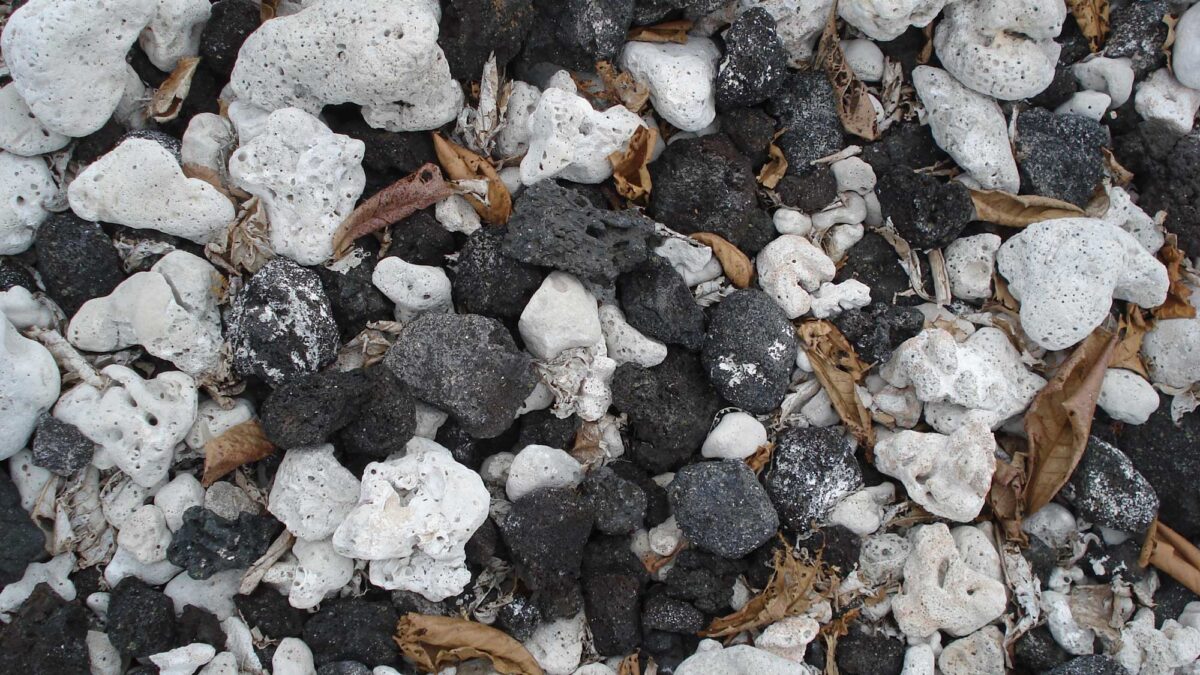Page Snapshot: Introduction the different types of rocks (sedimentary, igneous, metamorphic) and their classification.
Topics covered on this page: What are rocks?; What are the three main kinds of rocks?; Sedimentary rocks; Igneous rocks; Metamorphic rocks; The rock cycle; Resources.
Credits: Most of the text on this page was written by Jonathan R. Hendricks. A small portion comes from "Rocks of the Southeastern US" by Jane A. Picconi and Charles C. Smith, chapter 2 in The Teacher-Friendly Guide to the Geology of the Southeastern U.S., 2nd. ed., edited by Andrielle N. Swaby, Mark D. Lucas, and Robert M. Ross (published in 2016 by the Paleontological Research Institution; currently out of print). The book was adapted for the web by Elizabeth J. Hermsen and Jonathan R. Hendricks in 2021. Changes include formatting and revisions to the text and images. Credits for individual images are given in figure captions.
Updates: Page last updated December 1, 2021.
Image above: Black and white rocks on the west side of the Big Island of Hawaiʻi. The black rocks are basalt, a type of extrusive igneous rock. The white rocks are limestones constructed by corals. Photograph by Jonathan R. Hendricks.
What are rocks?
A rock is a naturally occurring solid substance composed of one or more minerals. A large chunk of rock salt might be composed of a single type of mineral: halite (NaCl). Most rocks, however, contain several (or more) different types of minerals, just as a chocolate-chip cookie is composed of several different types of ingredients (each analogous to a different type of mineral).
Interactive 3D model of a sample of granite, an intrusive igneous rock. The different colors of the rock correspond to different minerals, including biotite (black), potassium feldspar (pink), and quartz (clear). Specimen is from the teaching collection of the Paleontological Research Institution, Ithaca, New York. Longest dimension of specimen is approximately 10 cm.
What are the three main kinds of rocks?
Broadly speaking, there are three types of rock, each of which is introduced in greater detail below: sedimentary, igneous, and metamorphic.
Sedimentary rocks
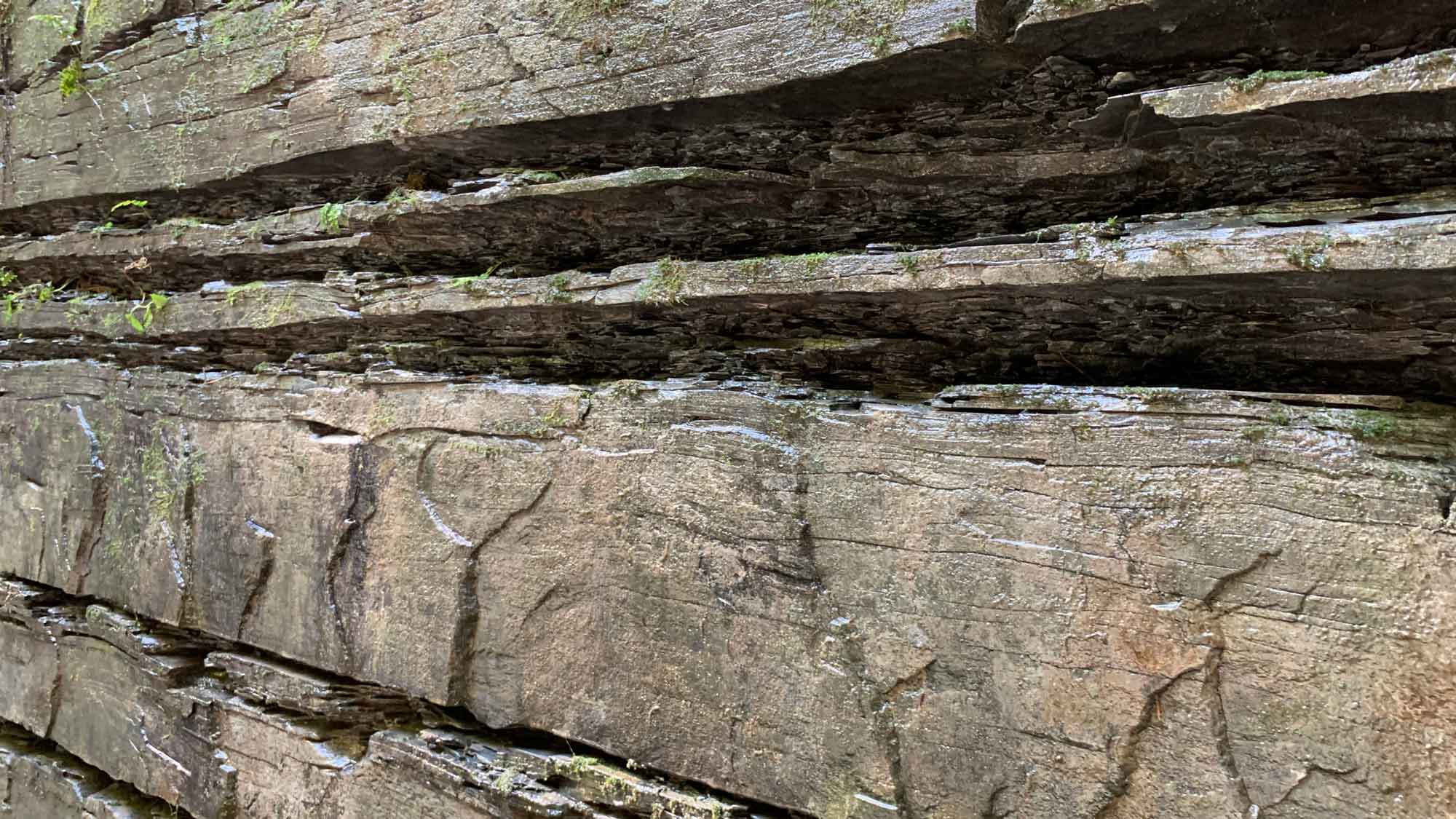
Layers of Devonian-aged siltstone and shale (siliciclastic sedimentary rocks) near Ithaca, New York. Photograph by Jonathan R. Hendricks.
There are two major groups of sedimentary rocks: 1) siliciclastic and 2) chemical and organic. Visible layering is common in sedimentary rocks. Most fossils are found in sedimentary rocks; exceptions are specimens found in metamorphic rocks that were once sedimentary (e.g., fossil shells in marble) or those found in ice (e.g., remains of mammoths).
Siliciclastic sedimentary rocks
Siliciclastic sedimentary rocks are composed primarily of silicate minerals (e.g., quartz, feldspar, etc.) broken away from older, preexisting igneous, metamorphic, or sedimentary rocks. The fragments of these preexisting rocks are often transported far away from their source rock prior to being deposited in basins, where they accumulate as sediments that later become rock following compaction and cementation (see rock cycle below). Siliciclastic sedimentary rocks are primarily classified based on their grain sizes and include conglomerate and breccia, sandstone, siltstone, and shale. Mineral composition is sometimes also used in the classification of siliciclastic sedimentary rocks.
| Sedimentary rock | Sediment size | Common depositional environment |
|---|---|---|
| Conglomerate and breccia | Gravel (>2 mm) | River beds, mountains |
| Sandstone | Sand (0.062 to 2 mm) | Beaches, river bars, dunes |
| Siltstone | Silt (0.0039 to 0.062 mm) | Slow moving water, offshore |
| Shale | Clay (less than 0.039 mm; microscopic) | Very slow moving water, deep ocean |
Types of siliclastic sedimentary rocks, the sizes of their largest sediment grains, and common environments in which they were deposited.
Chemical and organic sedimentary rocks
Chemical and organic sedimentary rocks are those that are precipitated from chemicals that are dissolved in water or are produced by the activities of organisms, or the accumulation of their remains. In contrast to siliciclastic sedimentary rocks that are composed of sediment grains that may have traveled great distances prior to being deposited, chemical and organic sedimentary rocks more-or-less formed where you find them. There are four major types:
- Carbonates (e.g., limestone and dolostone)
- Evaporites (e.g., rock salt and rock gypsum)
- Chert
- Coal.
These rocks are classified based on their mineral composition.
| Sedimentary rock | Composition | Common depositional environment |
|---|---|---|
| Limestone (carbonate) | Calcium carbonate (calcite or aragonite; CaCO₃) from skeletons of algae or animals, or precipitated from water | Tropical reefs, beaches, warm shallow seas, caves, hot springs |
| Dolostone (carbonate) | Dolomite ([CaMg(CO₃)₂)]) | Frequently a form of chemically altered limestone |
| Rock salt (evaporate) | Halite (salt; NaCl) | Drying seas, playas |
| Rock gypsum (evaporate) | Gypsum (CaSO₄.2H₂O) | Drying seas, playas |
| Chert | Silica (SiO₂) from skeletons of microorganisms and sponges | Ocean |
| Coal | Carbon (C) from ancient plant life | Swamps |
Types of chemical and organic sedimentary rocks, the sizes of their largest sediment grains, and common environments in which they were deposited.
Igneous rocks

Recently-erupted basalt lava (extrusive, mafic igneous rock) on the Big Island of Hawaiʻi. Photograph by Jonathan R. Hendricks.
Igneous rocks form from the cooling of magma (molten rock underground) or lava (molten rock at the Earth's surface). There are two major groups: 1) intrusive (also called plutonic) and 2) extrusive (also called volcanic).
Intrusive igneous rocks
Intrusive (or, plutonic) igneous rocks form from magma that has cooled below the Earth's surface. Because this cooling process is slow, visible (or, phaneritic) mineral grains have time to form and are usually visible with the naked eye. When any mineral grains in a sample exceed 2 cm in size, the rock is called a pegmatite.
Crystalline intrusive igneous rocks are classified based on their underlying mineral compositions (as are equivalent extrusive igneous crystalline rocks). Felsic intrusive igneous rocks (e.g., granite) are usually light in color because they are rich in minerals like feldspar that contain a lot of Al, Na, or K. Mafic intrusive igneous rocks (e.g., gabbro and peridotite) are darker in color, again reflecting the compositions of the minerals present, which tend to be rich in Mg and Fe. As might be expected, there are intrusive igneous rocks with compositions that are somewhere between felsic and mafic (e.g., granodiorite and diorite).
| Intrusive igneous rock | Color | Major minerals present | Crystal form | Extrusive equivalent |
|---|---|---|---|---|
| Granite | Mixed, including pink, light, and dark | Quartz, potassium feldspar, sodium-rich plagioclase, and biotite (felsic) | Large and interlocking | Rhyolite |
| Granodiorite | Mixed, including pink, light, and dark | Quartz, plagioclase, potassium feldspar, biotite, horneblende (intermediate) | Large and interlocking | Dacite |
| Diorite | Mixed, including light and dark | Plagioclase, quartz, horneblende, pyroxene (intermediate) | Large and interlocking | Andesite |
| Gabbro | Dark | Calcium-rich plagioclase, olivine, pyroxene (mafic) | Large and interlocking | Basalt |
| Peridotite | Green | Olivine, pyroxene (ultramafic) | Large and interlocking | Komatiite |
Major types of intrustive igneous rocks and their physical characteristics.
Extrusive igneous rocks
Extrusive (or, volcanic) igneous rocks are formed on the Earth’s surface as the result of volcanic activity. They tend to have small crystal sizes because they cool very quickly. These small crystals are referred to as aphanitic because they often cannot be seen with the naked eye. That said, larger, visible crystals called phenocrysts may be present within the surrounding groundmass (or, matrix) of aphanitic crystals. Extrusive igenous rocks with phenocrysts in an aphanitic matrix are called porphyry; they form when magma has partially cooled below the surface (forming the phenocrysts) and is then erupted and rapidly cooled (forming the aphenitic matrix).
The colors of extrusive igneous rocks depend upon the minerals present. Felsic extrusive igneous rocks (e.g., rhyolite) are usually light in color (though obsidian is a notable exception; see below) because they are rich in minerals like feldspar that contain a lot of Al, Na, or K. Mafic extrusive igneous rocks (e.g., basalt) are darker in color, again reflecting the compositions of the minerals present, which tend to be rich in Mg and Fe. There are, of course, extrusive igenous rocks with compositions that are somewhere between felsic and mafic (e.g., dacite and andesite): it is a continuum.
Most extrusive igneous rocks have textures composed of interlocking crystals of varying mineral composition. Others, such as tuff, formed from fragments that exploded out of the Earth, settled, and then become welded together as they quickly cool. Glassy extrusive igenous rocks such as obsidian, pumice, and scoria contain a large amount of silica (Si) and form when lava cools very quickly, preventing the formation of individual mineral grains; pumice and scoria vesicles, a result of air bubbles.being trapped in the lava before it cooled.
| Extrusive igneous rock | Color | Major minerals present | Crystal form | Intrusive equivalent |
|---|---|---|---|---|
| Rhyolite | Pink | Quartz, potassium feldspar, sodium-rich plagioclase, and biotite (felsic) | Small and interlocking | Granite |
| Dacite | Gray | Quartz, plagioclase, potassium feldspar, biotite, horneblende (intermediate) | Small and interlocking | Granodiorite |
| Andesite | Dark | Plagioclase, quartz, horneblende, pyroxene (intermediate) | Small and interlocking | Diorite |
| Basalt | Dark | Calcium-rich plagioclase, olivine, pyroxene (mafic) | Small and interlocking | Gabbro |
| Komatiite | Greenish | Olivine, pyroxene (ultramafic) | Small and interlocking | Peridotite |
| Tuff | Variable | Variable | None; lithified volcanic ash | n/a |
| Obsidian | Dark | Silica (felsic) | None; volcanic glass | n/a |
| Pumice | Gray | Felsic minerals | None; volcanic glass with small vesicles (holes) | n/a |
| Scoria | Dark (including reddish) | Mafic minerals | None; volcanic glass with large vesicles (holes) | n/a |
Major types of extrusive igneous rocks and their physical characteristics.
Metamorphic rocks
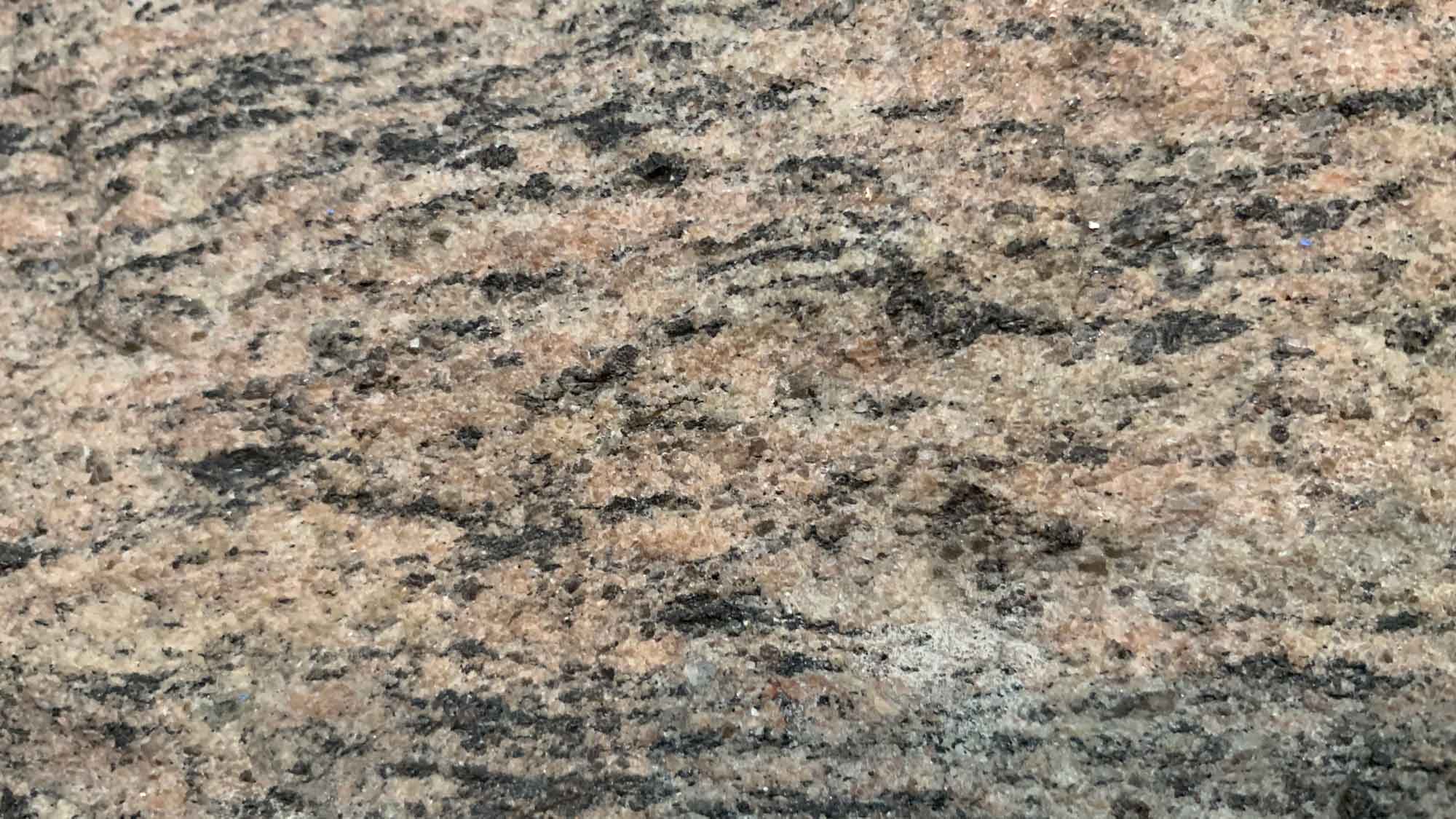
A sample of 1 billion-year-old (Precambrian) gneiss, a type of foliated metamorphic rock, from the Adirondacks of New York. Photograph by Jonathan R. Hendricks.
In a geologic sense, the texture of a rock has to do with the arrangement, sizes, and shapes of its crystals. Metamorphism always alters the texture of rock. Metamorphic rocks are grouped into two major categories based on their textures: 1) foliated and 2) non-foliated.
Foliated metamorphic rocks
Foliated metamorphic rocks show mineral grains that are grouped in parallel arrangements. This happens because platy minerals such as micas and chlorites become aligned at an angle relative to a direction of force. The six types of foliated metamorphic rocks highlighted below (slate, phyllite, schist, gneiss, amphibolite, and migmatite) are arranged by the increasing amount of temperature and pressure (or, metamorphic grade) required for their formation. They are classified based on the nature of their foliation and their crystal size.
| Foliated metamorphic rock | Appearance | Mineral grains | Pre-metamorphic source | Metamorphic grade |
|---|---|---|---|---|
| Slate | Dark; breaks at angle relative to original bedding | Microscopic; clays, micas, chlorite | Shale or volcanic ash | Low |
| Phyllite | Shiny | Microscopic or small size; micas, quartz, chlorite | Shale | Low to medium |
| Schist | Sparkly, like fish scales | Small to medium size; micas, chlorite, quartz, talc, garnet, hornblende, graphite common | Shale, carbonates, or mafic igneous rocks | Low to high |
| Gneiss (pronounced "nice") | Distinct bands of light-and dark-colored minerals | Large size; quartz, feldspars, micas, and hornblende. | Shale, sandstone, or felsic igneous rocks | High |
| Amphibolite | Dark, with weak foliation | Large size; hornblende and plagioclase | Mafic (dark-colored) igneous rock | Medium to high |
| Migmatite | Mixture of metamorphic (e.g., gneiss) and felsic igneous rock (e.g., granite); folded banding common | Large size; quartz, feldspar, micas, hornblende. | Felsic (light-colored) igneous rock | High |
Major types of foliated metamorphic rocks, their physical characteristics, their pre-metamorphic source, and their metamorphic grade.
Non-foliated metamorphic rocks
Non-foliated metamorphic rocks lack foliated texture because they often lack platy minerals such as micas. They commonly result from contact or regional metamorphism. Examples include marble, quartzite, greenstone, hornfel, and anthracite.
| Non-foliated metamorphic rock | Appearance | Mineral grains | Pre-metamorphic source | Metamorphic grade |
|---|---|---|---|---|
| Marble | Variable | Interlocking grains of calcite or dolomite | Carbonates: limestone or dolostone | Low to high |
| Quartzite | Variable | Interlocking grains of quartz | Sandstone | Medium to high |
| Greenstone | Greenish | Small; chlorite, epidote, hornblende | Mafic igneous rock | Low to high |
| Hornfel | Banding sometimes present, but not associated with foliation; very hard | Micas, garnets, quartz | Shale | Low to high |
| Anthracite | Black, shiny | Microscopic; carbon | Coal | High |
Major types of non-foliated metamorphic rocks, their physical characteristics, their pre-metamorphic source, and their metamorphic grade.
What is the rock cycle?
Over geologic time scales, rocks sometimes turn into other sorts of rocks. The rock cycle explains this process of transformation. It is a major Earth system that has operated since the Earth's origin, and it continues today. The energy that drives weathering and erosion at Earth's surface—as well as, melting, or an increase in heat or pressure below Earth's surface—drives the continuation of the rock cycle.
It is useful to visualize the rock cycle as a square. The four sides represent the three rock types (sedimentary, igneous, and metamorphic), as well as loose sediments that have not yet turned into sedimentary rock. The four corners represent the processes and factors that turn one type of rock into another:
- Weathering and erosion
- Sedimentary processes
- Heat and pressure
- Melting and cooling.
These connections are described below.

The rock cycle. Image by Jonathan R. Hendricks for the Earth@Home project.
Weathering and erosion
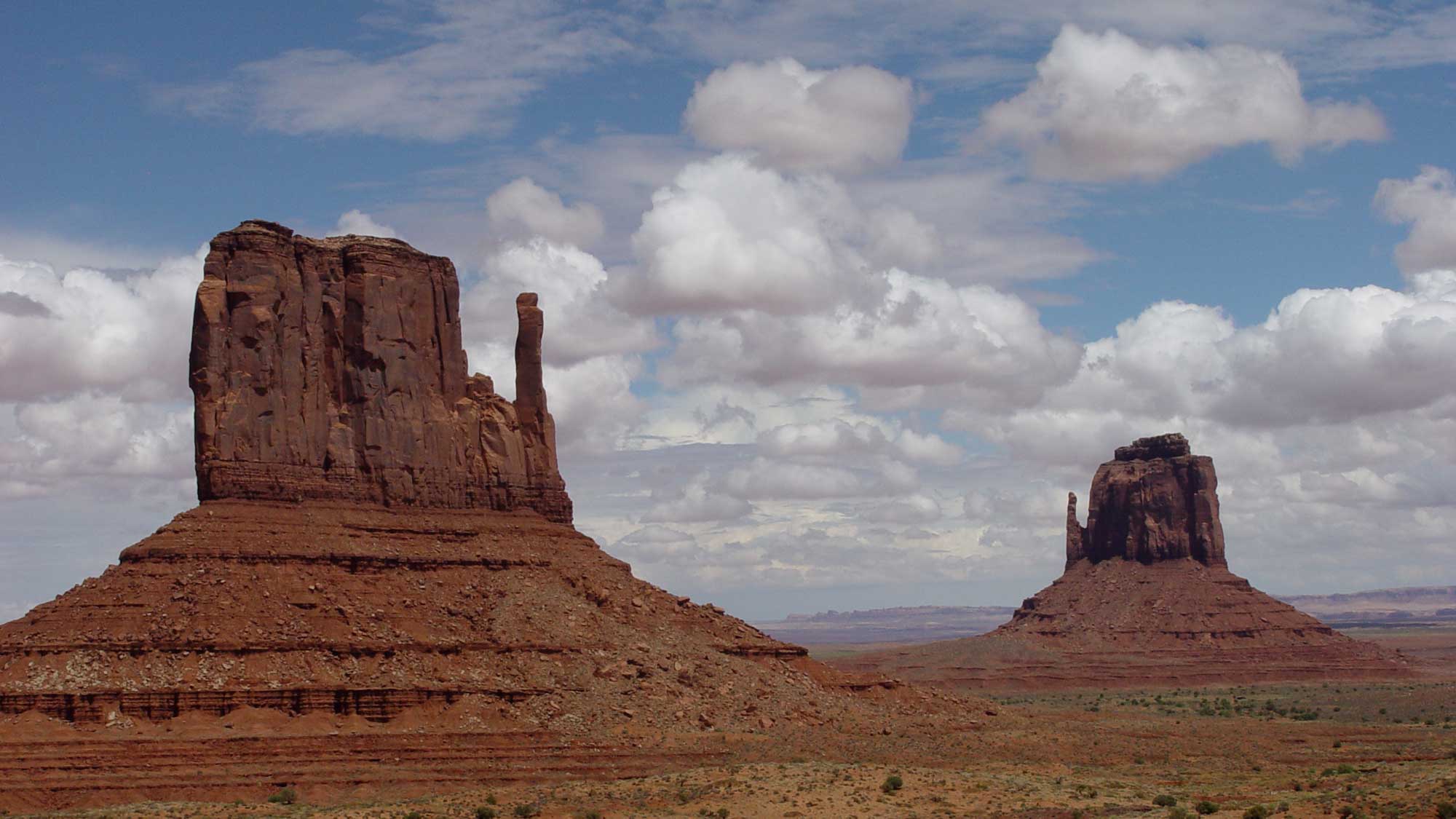
West Mitten Butte (left) and East Mitten Butte (right) at Monument Valley (Tsé Biiʼ Ndzisgaii) on the land of the Navajo Nation Reservation. These spectacular rock formations are a result weathering and erosion. Photograph by Jonathan R. Hendricks.
Weathering
Weathering is the process that causes rocks on Earth's surface to become broken into sediments, which range in size from boulders to individual, microscopic mineral grains.
There are two types of weathering:
- Chemical
- Physical.
Chemical weathering
Chemical weathering results from certain minerals in a rock sample dissolving away (for example, because of acidic groundwater), causing resistant grains to become dislodged.
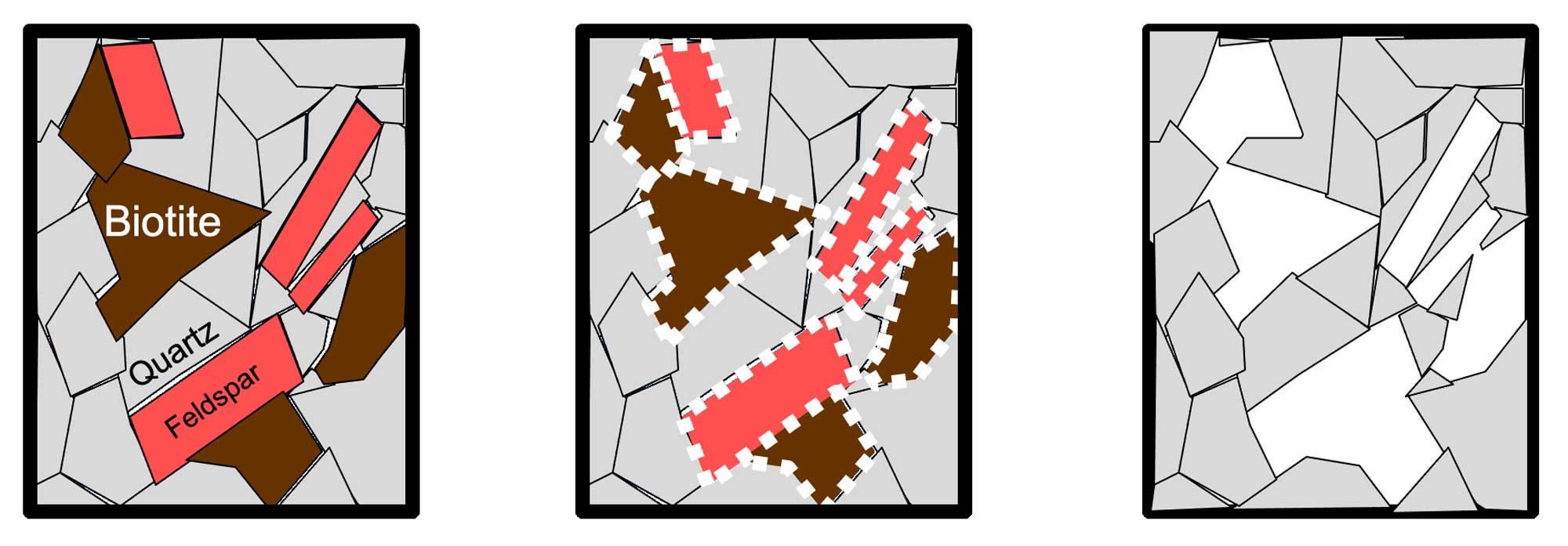
Example of chemical weathering of a rock sample composed of biotite, feldspar, and quartz. The biotite and feldspar grains are less resistant than the quartz grains and begin to dissolve away. After they have fully dissolved, all that remains are quartz grains that no longer remain locked together, leading them to erode away. Image by Jonathan R. Hendricks for the Earth@Home project.
Physical weathering
As its name implies, physical weathering is caused by physical factors that break a rock apart. One example is the natural freezing and thawing cycle in cold climates: water fills cracks in the rock, expands as it freezes, and breaks the rock. Growing plant roots can also cause rocks to be broken.

A rock outcrop near Athens, Ohio that shows erosion (boulder at bottom of image) resulting from physical weathering as a result a likely combination of repeated freezing and thawing (note icicles in image) and tree roots. Photograph by Jonathan R. Hendricks.
Erosion
Erosion involves the transportation of weathered sediments from one place to another, by water, wind, or gravity. High-energy events like major storms transport much more sediment than occurs normally. This is because rapidly moving water or air can carry a greater volume of sediment than slowly moving water or air.
Erosion ends when the material stops being transported, typically when it reaches the location where it is deposited.

Panorama view of two streams coming together (confluence) in Denali National Park, Alaska. The stream at the bottom of the image is brown because of the large amount of sediment it is carrying. Note also the loose sediment (pebbles) at the bottom and sides of the image. Photograph by Jonathan R. Hendricks.
Rock cycle connections
- All types of exposed rocks are subjected to weathering and erosion.
- Sediments themselves can be subjected to further erosion if they are removed from their place of deposition.
Sedimentary processes
Sedimentary processes convert loose sediments into sedimentary rock. These processes include deposition, burial, compaction, and cementation. Note that chemical and organic sedimentary rocks like limestone, halite, and coal form in place and not as a result of transportation.
Deposition
Loose sediments (ranging in size from large boulders to microscopic grains) are transported by wind, water, or gravity until they can be moved no further. This often results when they encounter a basin such as a lake or the ocean. Deposition occurs when the sediment grains stop moving.
Burial
Following deposition, loose sediments pile on top of each other, forming layers. New layers bury older layers. Individual layers often correspond to large storm events that move a lot of sediment at once.
Compaction
A body of sediment becomes heavier and heavier as more layers are added. This causes the sediment grains to become more closely squished together over time. This process is known as compaction.
Cementation
Over time, minerals that are dissolved in water may precipitate out (or, form crystals) between individual sediment grains, causing them to become cemented (or, locked) together. Calcite is a common type of cement.
Rock cycle connections
- On geologic time scales, loose sediments are transformed into sedimentary rock by the processes of deposition, burial, compaction, and cementation.
Heat and pressure
Heat and pressure can cause rocks of any type to change to other kinds of rocks through the process of metamorphism. The heat and pressure involved in metamorphism can result from:
- Burial of rocks at great depths.
- Tectonic forces.
- Proximity to magma.
Many of the oldest rocks on Earth are metamorphic. This is because they have been subjected to numerous intervals of heat and pressure over their ancient histories.
Importantly, metamorphism does not involve the melting of rocks. A melted rock becomes magma or lava, which turns into an igneous rock after cooling.
Rock cycle connections
- Exposure to heat and pressure can cause sedimentary and igneous rocks to become metamorphic rocks.
- Metamorphic rocks can even change into other kinds of metamorphic rocks. For example, exposure to increased heat and pressure can change a low-grade metamorphic rock to change into a high-grade metamorphic rock.
Melting and cooling
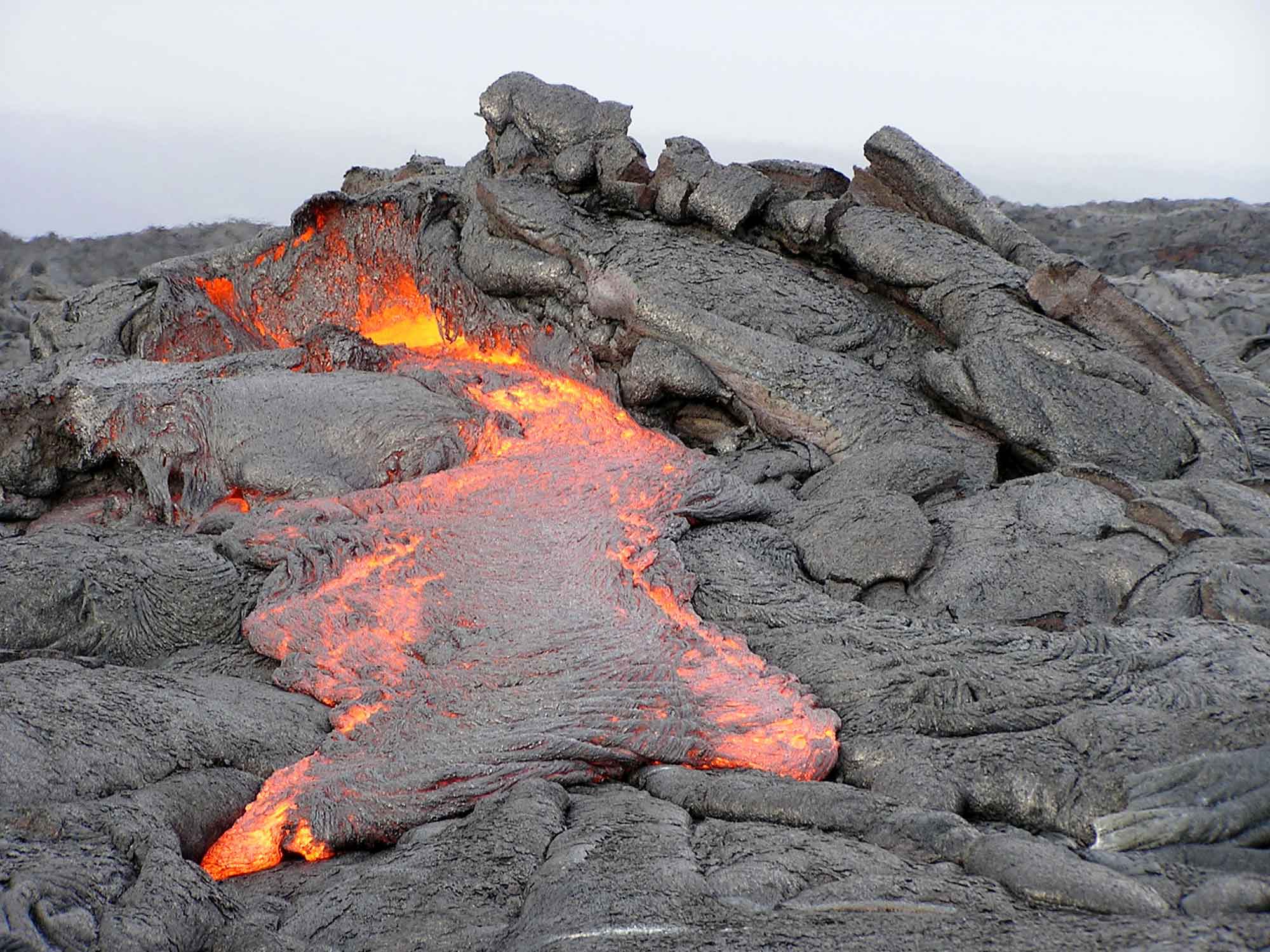
A lava flow at Hawaiʻi Volcanoes National Park. As soon as the lava cools, it forms basalt, a dark-colored extrusive igneous rock. Photograph by Scot Nelson (Flickr; public domain).
Any time an existing rock—whether sedimentary, metamorphic, or igneous—melts, cools, and re-solidifies, the result is a new igneous rock. Most rocks on Earth are ultimately derived from magma or lava that cooled to form, respectively, extrusive or intrusive igneous rocks. (Exceptions include chemical and organic sedimentary rocks). For example, most of the grains that form beach sand (which might one day become sandstone) are derived from weathered and eroded igneous rock.
Significant melting of crustal rocks occurs at convergent plate boundaries. Subducted crust melts within Earth's hot mantle. This recycled, melted rock becomes magma that is eventually re-erupted at Earth's surface, either at volcanos (as lava) or divergent plate boundaries like the Mid-Atlantic ridge.
Rock cycle connections
- Existing sedimentary, metamorphic, and igneous rocks can all be melted to form magma that, upon cooling, results in the formation of a new igneous rock.
Resources
Resources from the Paleontological Research Institution
Digital Encyclopedia of Earth Science: Minerals: https://earthathome.org/de/minerals/
Earth@Home Virtual Collection: Rocks: https://earthathome.org/vc/rocks/ (Virtual rock collection featuring 3D models of rock specimens sorted by type.)



